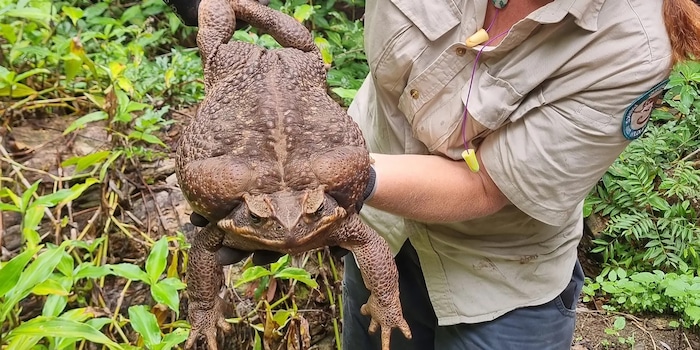
Toadzilla has been captured
Aga toads have a notoriously bad reputation in Australia: the introduced amphibians eat their way through the native fauna - especially when they get that big.
It all began with good intentions: in the 1930s, Australians introduced aga toads (Rhinella marina) to Queensland to protect the valuable sugar cane plantations from voracious beetles. However, the poisonous amphibians were not limited to the six-legged creatures, but developed a large appetite for other amphibians, snakes, small mammals and birds and spread massively across the fifth continent. Today, they are regarded as a threatening land plague that is being fought with all available means. But sometimes individual specimens shock even hardened rangers, as the Queensland Department of Environment and Science reports.
Kylee Gray was travelling with her team in Conway National Park in Queensland when they had to stop their vehicle because a snake crossed their path. When they got out for a closer look, they noticed a huge aga toad right next to the road. "I grabbed the toad and couldn't believe how big and heavy it was," said Gray. "We named it Toadzilla and quickly put it in a container so we could remove it from the wild."
In total, the animal weighed 2.7 kilograms and turned out to be a female, as closer examination revealed. These are larger than the males, but no other specimen has ever been found in these dimensions. It may even be a new weight record for the species. "An aga toad of this size will eat anything that fits in its mouth, including insects, reptiles and small mammals," says Gray. It remains unclear how old the animal is. However, these amphibians can live up to 15 years. Given its size, Gray and co. suspect that the animal had been living in the area for a long time.
As female aga toads can lay up to 30,000 eggs per season, the rangers are happy to have caught the specimen, which is called Toadzilla. It may end up in the Queensland Museum, as the toad could be the new record holder of the species. Aga toads have few natural enemies in Australia, as predators such as martens, snakes and crocodiles are not adapted to their venom and can die from eating them. Conversely, the amphibians consume many Australian species and endanger them. As pets have also died from their poison, these amphibians are being fought intensively - without this having stopped their advance. They are now native to large areas of eastern and northern Australia.
Spectrum of science
We are partners of Spektrum der Wissenschaft and want to make well-founded information more accessible to you. Follow Spektrum der Wissenschaft if you like the articles.
[[small:]]
Cover image: © Queensland Department of Environment and Science (detail). Rangers only found this giant aga toad by chance. Because of its size, they named the amphibian «Toadzilla».
Experts from science and research report on the latest findings in their fields – competent, authentic and comprehensible.
From the latest iPhone to the return of 80s fashion. The editorial team will help you make sense of it all.
Show all